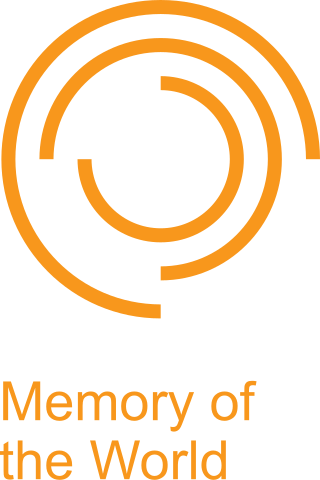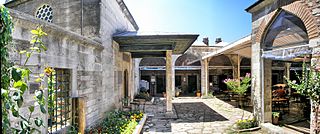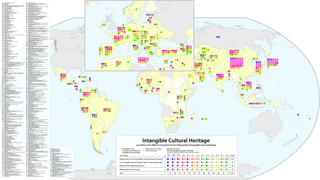The International Council on Monuments and Sites is a professional association that works for the conservation and protection of cultural heritage places around the world. Now headquartered in Charenton-le-Pont, France, ICOMOS was founded in 1965 in Warsaw as a result of the Venice Charter of 1964 and offers advice to UNESCO on World Heritage Sites.
The International Council of Museums (ICOM) is a non-governmental organisation dedicated to museums, maintaining formal relations with UNESCO and having a consultative status with the United Nations Economic and Social Council. Founded in 1946, ICOM also partners with entities such as the World Intellectual Property Organization, Interpol, and the World Customs Organization in order to carry out its international public service missions, which include fighting illicit traffic in cultural goods and promoting risk management and emergency preparedness to protect world cultural heritage in the event of natural or man-made disasters. Members of the ICOM get the ICOM membership card, which provides free entry, or entry at a reduced rate, to many museums all over the world.

UNESCO's Memory of the World (MoW) Programme is an international initiative launched to safeguard the documentary heritage of humanity against collective amnesia, neglect, decay over time and climatic conditions, as well as deliberate destruction. It calls for the preservation of valuable archival holdings, library collections, and private individual compendia all over the world for posterity, the reconstitution of dispersed or displaced documentary heritage, and increased accessibility to, and dissemination of, these items.
The Venice Charter for the Conservation and Restoration of Monuments and Sites is a set of guidelines, drawn up in 1964 by a group of conservation professionals in Venice, that provides an international framework for the conservation and restoration of historic buildings. However, the document is now seen by some as outdated, representing Modernist views opposed to reconstruction. Reconstruction is now cautiously accepted by UNESCO in exceptional circumstances if it seeks to reflect a pattern of use or cultural practice that sustains cultural value, and is based on complete documentation without reliance on conjecture. The change in attitude can be marked by the reconstruction in 2015 of the Sufi mausoleums at the Timbuktu World Heritage Site in Mali after their destruction in 2012.
Australia ICOMOS is a peak cultural heritage conservation body in Australia. It is a branch of the United Nations-sponsored International Council on Monuments and Sites (ICOMOS), a non-government professional organisation promoting expertise in the conservation of place-based cultural heritage. Its secretariat is based at the Cultural Heritage Centre for Asia and the Pacific at Deakin University.
The Aga Khan Trust for Culture (AKTC) is an agency of the Aga Khan Development Network (AKDN), a family of institutions created by Aga Khan IV with distinct but complementary mandates to improve the welfare and prospects of people in the developing world, particularly in Asia and Africa. It focuses on the revitalization of communities in the Muslim world—physical, social, cultural, and economic. The AKTC was founded in 1988 and is registered in Geneva, Switzerland, as a private non-denominational philanthropic foundation.
The International Institute for Conservation of Historic and Artistic Works (IIC) is a global organisation for conservation and restoration professionals with over two thousand members in over fifty countries. IIC seeks to promote the knowledge, methods and working standards needed to protect and preserve historic and artistic works throughout the world.

The Caferağa Medrese or Cafer Ağa Madrasa is a former medrese, located in Istanbul, Turkey, next to the Hagia Sophia. It was built in 1559 by Mimar Sinan on the orders of Cafer Agha, during the reign of Sultan Suleiman the Magnificent (1520-1566).

The World Heritage Convention, formally the Convention Concerning the Protection of the World Cultural and Natural Heritage, is an international treaty signed on 23 November 1972, which created the World Heritage Sites, with the primary goals of nature conservation and the preservation and security of cultural properties. The convention, a signed document of international agreement, guides the work of the World Heritage Committee. It was developed over a seven-year period (1965–1972).
The 1979 Montenegro earthquake occurred on 15 April at 06:19 UTC with a moment magnitude of 6.9 and a maximum Mercalli intensity of X (Extreme). It was the most devastating earthquake in SR Montenegro, then part of Yugoslavia, and was mostly felt along the Montenegrin and Albanian coastline. It was also felt in other parts of the country.
Harold James Plenderleith MC FRSE FCS was a 20th century Scottish art conservator and archaeologist. He was a large and jovial character with a strong Dundonian accent.

UNESCO established its Lists of Intangible Cultural Heritage with the aim of ensuring better protection of important intangible cultural heritages worldwide and the awareness of their significance. This list is published by the Intergovernmental Committee for the Safeguarding of Intangible Cultural Heritage, the members of which are elected by State Parties meeting in a General Assembly. Through a compendium of the different oral and intangible treasures of humankind worldwide, the programme aims to draw attention to the importance of safeguarding intangible heritage, which UNESCO has identified as an essential component and as a repository of cultural diversity and of creative expression.

Andrzej Stanisław Tomaszewski was a Polish historian of art and culture, architect, urban planner and archaeologist. He was investigator of medieval architecture and art in Poland and abroad. He was considered one of the most important and influential international scientists in the preservation and conservation of cultural heritage.

The Arab Regional Centre for World Heritage is a Category 2 Centre under the auspices of UNESCO. founded as an autonomous and independent Bahraini public institution in 2010.
Mounir Bouchenaki is an Algerian archaeologist and incumbent Director of the Arab Regional Centre for World Heritage. He was Director-General of ICCROM from 2006 to 2011, UNESCO's Assistant Director General for Culture (2000-2006), Director of the World Heritage Centre (1998-2000), Director of UNESCO's Cultural Heritage Division (1990-2000). In January 2011, he was named honorary special adviser of UNESCO Director-General Irina Bokova and of ICCROM Director-General.

A conservation scientist is a museum professional who works in the field of conservation science and whose focus is on the research of cultural heritage through scientific inquiry. Conservation scientists conduct applied scientific research and techniques to determine the material, chemical, and technical aspects of cultural heritage. The technical information conservation scientists gather is then used by conservator and curators to decide the most suitable conservation treatments for the examined object and/or adds to our knowledge about the object by providing answers about the material composition, fabrication, authenticity, and previous restoration treatments.
Om Prakash Agrawal was an Indian Conservationist and the founder member of several organizations related to cultural heritage and conservation such as Indian National Trust for Art and Cultural Heritage (INTACH), Indian Council of Conservation Institute (ICCI) and the National Research Laboratory for the Conservation of Cultural Property (NRLC). He was the director general of INTACH Indian Conservation Institute and director general of ICCI and NRLC. The Government of India honoured him in 2011, with the award of Padma Shri, the fourth highest Indian civilian award for his contributions to the area of conservation.

Abdolrasool Vatandoust Haghighi is an Iranian archaeologist.
Webber Ndoro was the Director-General of ICCROM from 2017 to 2023. He is considered the first professional Zimbabwean cultural heritage manager, and amongst the first trained Zimbabwean archaeologists.








